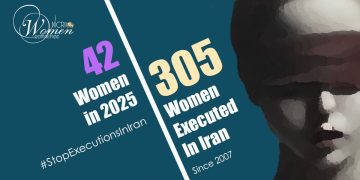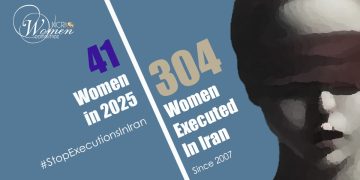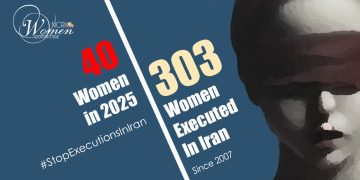The clerical government is the prime suspect in the murder of women.
Iran is one of six countries across the globe that have not yet signed the Convention on the Elimination of All Forms of Discrimination Against Women.
Iranian women are denied the most basic rights, including the right to divorce, custody, travel, education, employment, and clothing.
The mullahs’ laws recognize men’s second through fourth marriages and their unilateral decisions to divorce. The laws also allow men to beat women and children. These laws make men the owners of their family members’ blood and lives.
Violence against women that results in their murder is, of course, an issue that women around the world suffer to some degree. What is different in Iran are the law and the regime, which, in contradiction to international obligations, bases its power on misogyny and encourages and supports archaic views and a culture of violence against women.
24 murders and thousands of untold stories of Iranian women

In 2010, Mojtaba Borhani, the Ahvaz Special Murder Branch investigator said, “Many honor killings are based on suspicion and lack evidence” (The state-run Tabnak website – September 20, 2020).
This terrible fate was repeated last year for countless Iranian women and girls.
Kowsar Gol Soghanloo, 15, from Piranshahr, died after her husband set her on fire on February 19, 2020. She had been married at the age of 14 (Hengaw website – February 23, 2020).
Hadith, 11, from Khoy, choked to death after his father strangled her with a belt on March 18, 2020. The father had already researched the punishment for murdering his child before committing the crime and knew that the law would not impose a severe punishment on him for murder. He had also repeatedly threatened to kill Hadith’s mother (The state-run Etemadonline.ir– March 18, 2020).
Hajareh Hussein Bor, 20, from Sistan and Baluchestan, was murdered by her husband on May 4, 2020. She had been forced to marry at the age of 16 and had a 2-year-old son. Hajareh was beaten repeatedly several times by her husband and burned with a hot wire, but no one paid attention to her complaints (Iran Global – May 10, 2020).
Romina Ashrafi, 13, from Talesh, was killed when her father beheaded her with a sickle on May 21, 2020, while she was asleep. She had run away with a boy who was planning to marry her but was arrested. The judge sent her home, despite her insistence that her father had been abusing her (The state-run Didar news website – May 21, 2020).
Fatemeh Barhi, 19, was beheaded by her husband on June 14, 2020, in Abadan. She had married her cousin the year before as part of a forced marriage. Fatemeh fled to Mashhad to escape the life that had been forced on her and moved in with one of her friends. Her husband found her, took her back to Abadan, and killed her (The state-run ROKNA news agency – June 16, 2020; the state-run khabarfori.com– June 20, 2020).
On the same day (June 14, 2020), another woman named Mina was killed by her ex-husband (The state-run Hamshahrionline.ir, June 24, 2020)
Reyhaneh Ameri, 22, from Kerman, was killed by her father with an ax on June 15, 2020. Reyhaneh’s father had already tried to kill her 3 years earlier; he broke her arms and legs, but her sisters managed to intervene just in time. The Kerman prosecutor called the murder “unintentional” (The state-run ROKNA news agency – June 16, 2020; the state-run khabarfori.com– June 20, 2020).
In June, another young girl was killed by her brother in Abadan (The state-run khabarfori.com– June 20, 2020).
Somayeh Fathi, 18, from Kurdistan, was killed by her father and brother on June 18, 2020, with aluminum phosphide pills, known as rice pills. Somayeh was married and pregnant. Neither of her killers was arrested or interrogated (The state-run Hamshahrionline.ir, June 24, 2020).
In June 2020, a woman from Zarand was brutally murdered by her husband, an addict. The video of her torture was posted on the state-run Rokna news agency on June 20, 2020.
A young woman from Maragheh was set on fire by her husband on July 23, 2020, and died in Tabriz Hospital on July 27, 2020. The woman had filed for divorce several times, but the regime’s judicial authorities ignored her requests (The state-run ROKNA News Agency – June 27, 2020).
A 20-year-old girl from Kuhdasht went into a coma on July 14, 2020, after her father hit her with a hammer. After committing the crime, the father, who had also killed his wife, committed suicide (The state-run ROKNA News Agency – July 14, 2020).
The body of 15-year-old Fatemeh Moradi, a resident of Kolah Kaboud village in Ravansar, was discovered on July 17, 2020 (The state-run ILNA news agency – July 17, 2020).
Parang Ghazi, from Mahabad, was killed on July 19, 2020, after being beaten by her husband. She had a master’s degree in English (The state-run ROKNA news agency – July 23, 2020).
Fatemeh Ghozati, 16, died after her step-uncle threw her out of an 11th-floor window of their building on July 23, 2020. The mother watched the crime take place, and despite her and Fatemeh’s stepfather’s complaints, the killer was released on bail and continuously threatened the family. The regime’s Judiciary described the murder as a suicide (The state-run Bahar news agency – June 14, 2020).
Fatemeh Kebriaii, 28, was killed by her husband on August 15, 2020. She had been planning to divorce him for a year. She fled his abuse and lived with her father 50 days before she was murdered. Under the pretext of trying to reconcile, the husband dragged Fatemeh home and, at the end of a particularly violent fight, hit Fatima against the wall so hard that her skull broke. She died after being in a coma for several days. Fatemeh had graduated from university with a degree in architecture (Iran wire website – August 15, 2020).
Leila, a resident of the village of Sepidar in Boyer Ahmad, was shot dead by her husband in August. The killer, who had previously tried to kill Leila with an ax, had been arrested and imprisoned. He was released from prison just a few minutes before the murder as a coronavirus leave (The state-run ILNA news agency – August 27, 2020).
A pregnant woman living in Esfarayen died, along with her unborn baby, in the hospital on August 28, 2020, after being severely beaten by her husband (The state-run Hamshahrionline.ir, August 28, 2020).
A woman from a village near Shazand City was stabbed after she had an argument with her husband on August 31, 2020. She died after arriving at the hospital (The state-run Iran Daily – August 31, 2020).
Fatemeh Hawasi, 16, from Qal’eh-Shahin, Sarpol-e-Zahab district, was shot dead by her brother on August 31, 2020 (Hengaw website – September 7, 2020).
Maryam Atmani, from Urmia, who was set on fire by her husband a week earlier, died of burns on September 19, 2020. She was the mother of two young children (The state-run ILNA news agency – September 20, 2020).
On the same date, another woman was killed by her husband in Zanjan (The official IRNA news agency – September 19, 2020).
Sarina Ghafouri, 25, was killed by her brother in May 2020. She made a living by sewing and lived with her 5-year-old daughter. Sarina’s brother, who had beaten her many times to prevent her from remarrying, eventually killed her (BBC website – May 28, 2020).
A quick look at these stories clearly shows that many of the victims were killed as a result of forced and early marriages and other official laws of the country. The proposed bill to increase the legal age of marriage from 13 to 16 was rejected by the mullahs’ parliament.
Law gives the green light to murder women in Iran
Article 1105 of the clerical regime’s civil code considers the man – exclusively – to be the head of the family. Article 1108 emphasizes that if a woman refuses to perform her “duties” toward her husband, she will not receive alimony. Article 1114 of the civil code stipulates that a woman must live in a house designated by her husband.
According to the same law, in order to file for divorce, a woman must be able to prove that living with that man is life-threatening, while the testimony of two women is equivalent to that of a man.
In many cases, a woman who has been beaten or stabbed is forced to return to live with the same perpetrator, even after complaining to legal authorities.
According to Mostafa Eghlima, President of the Iranian Scientific Social Welfare Association, “Unfortunately, specialists in this field are not present in social emergencies, safe houses and…the absence of such assistants makes judges hand over Romina to her father, or have hundreds of other girls return home without being monitored and cared for. As a result, these girls are killed by their fathers, husbands, and brothers” (The state-run Khabarfori.ir– June 20, 2020).
Ali Bagheri, a lawyer, points to the father’s and paternal grandfather’s legal immunity from retaliation. He says, “There is no correlation between the crime and the amount of punishment imposed on Romina’s father. Romina Ashrafi’s father thought he was the owner of this child and that he could kill her with a sickle. When the judge asked Romina’s father why he did not kill Bahman Khavari, the man with whom Romina had fled, he answered, “If I had killed Bahman Khavari, they would have retaliated against me. But this did not happen with my daughter. “
“The fact that additional punishments for Romina’s father were not considered caused considerable distress for Reyhaneh’s family in following up on her murder by her father in Kerman,” he added (The state-run Ensaf News website – September 11, 2020).
The lawyer emphasizes, “Judgments are not deterrents, and such cases cause us to witness even more murders of girls. The lack of protective laws makes the offender more likely to re-offend and exposes the victim to double the fear” (The state-run Ensaf News website – September 11, 2020).
The Perspective on Murder of Women in Iran
The state-run ISNA news agency estimates that the average number of honor killings in Iran is between 375 and 450 per year. Honor killings account for about 20% of all murders. It also accounts for 50% of all homicides (The state-run ISNA news agency – December 7, 2019).
There are no statistics on the murder of women in 2020. However, by reviewing the cited examples and increasing mental disorders resulting from the Coronavirus and economic and social problems, it can be concluded that society has entered a new phase of violence, which will definitely increase the violence that leads to women’s murder in Iran. “Honor killings have been on the rise in a strange way in recent times,” says Mustafa Eghlima (The state-run Khabarfori.ir – June 20, 2020).
Murder of women in Iran – Who is the real criminal?

While knives, sickles, or any other weapons in all their forms are in the hands of a father, brother, husband or another family member, preventing more murders of women requires that misogynist thought be condemned and destroyed. Under the current regime, the prevailing medieval view is that officially and in all laws, women are second-class citizens and subservient to men. This idea is part of the mullahs’ ideological pillar in the basis of all policies. For example, in the case of compulsory veiling, violation of the law of compulsory veiling is considered a matter of national security and carries the heaviest penalties.
The misogynistic performance of the ruling judiciary can be easily understood in a few simple comparisons. For example, Romina Ashrafi’s father was sentenced to only 9 years in prison for the murder of his teenage girl, a sentence that can actually be purchased.
Salman Khodadadi essentially went unpunished for his possible rape and murder of Zahra Navidpour. But Massoumeh Sanobari was sentenced to 8 years in prison for her political activities; and Salbi Marandi, 80, spent 7 months in Khoy prison after enduring 70 lashes for protesting her son’s murder.
In addition, the majority of the 109 women executed under Rouhani’s government were victims of forced child marriage who were hanged for murdering their husbands.
Indeed, if anyone is to be punished, it is the government that transforms misogyny into the dominant, official culture and that perpetuates violence against women by humiliating women on a daily basis, in addition to the arrests of at least 2,000 women per day simply for hijab-related violations.
In a structure such as the one in Iran, even if the killer is punished, a state assassination adds to the regime’s crimes and spreads the killing. However, the context and form of the issue still remain, and the men of this intellectual apparatus are increasingly driven to brutal behavior.
























